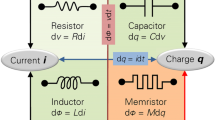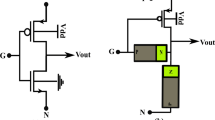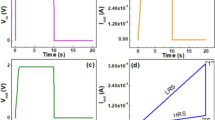Abstract
Memristor-CMOS (MCM) technology combines CMOS processing with nano-scale memristors enabling a significant reduction in the silicon area as compared to CMOS-only counterparts. Moreover, the non-volatile memory characteristics of the memristor offers opportunity for new and innovative MCM hybrid VLSI circuits that can outperform conventional CMOS designs. MCM based hybrid, homogeneous re-configurable architectures have already gained immense popularity among digital VLSI designers. This paper explores application of \(TiO_{2-x}\)–\(TiO_{2}\) charge trap memristor for programmable analog VLSI applications. The threshold adaptive memristor SPICE model has been used to evaluate the performance of the memristor in electronic design automation tool in conjunction with 45 nm CMOS devices. A digitally controlled MCM analog buffer, MCM binary phase shift keying modulator and a variable gain MCM differential amplifier has been presented in this paper. The MCM analog buffer has 81% greater gain-bandwidth product than the corresponding CMOS-only buffer and has an attenuation of \(-32\) dB when the control signal is low. A MCM differential amplifier is proposed whose gain can be varied in both directions by shifting the operating point of the memristor through control signals, proving the advantages of using MCM technology for automatic gain control and other programmable analog VLSI applications. A MCM BPSK modulator circuit is also proposed which occupies 37.2% lesser silicon area than the conventional CMOS-only BPSK modulators, thus illustrating the utility of memristor in analog switching circuits.













Similar content being viewed by others
References
L. Chua, IEEE Trans. Circuit Theory 18(5), 507 (1971)
D.B. Strukov, G.S. Snider, D.R. Stewart, R.S. Williams, Nature 453(7191), 80 (2008). https://doi.org/10.1038/nature06932
A.N. Belov, A.A. Golishnikov, A.M. Mastinin, A.A. Perevalov, V.I. Shevyakov, Semiconductors 53(15), 2024 (2019). https://doi.org/10.1134/S1063782619150041
M. Zabeli, N. Caka, M. Limani, Q. Kabashi, in Proceedings of the 6th Conference on {Microelectronics}, nanoelectronics, optoelectronics. MINO’07 (World Scientific and Engineering Academy and Society (WSEAS), Stevens Point, 2007), pp. 54–58
L. Wei, F. Boeuf, T. Skotnicki, H.P. Wong, IEEE Trans. Electron Devices 58(5), 1361 (2011)
Jyi-Tsong Lin, Chih-Hao Kuo, Tai-Yi Lee, Yi-Chuen Eng, Tzu-Feng Chang, Po-Hsieh Lin, Hsuan-Hsu Chen, Chih-Hung Sun, Hsien-Nan Chiu. in 2009 16th IEEE International Symposium on the Physical and Failure Analysis of Integrated Circuits, pp. 75–78 (2009)
J. Cong, B. **ao, in 2011 IEEE/ACM International Symposium on Nanoscale Architectures, pp. 1–8 (2011)
D. Strukov, S. Williams, Proc. Natl. Acad. Sci. U. S. A. 106, 20155 (2009). https://doi.org/10.1073/pnas.0906949106
K.T.T. Cheng, D. Strukov, Proc. Int. Symp. Phys. Des. (2012). https://doi.org/10.1145/2160916.2160925
M. Khalid, S. Mukhtar, M.J. Siddique, S.F. Ahmed, Trans. Electr. Electron. Mater. 20(5), 403 (2019). https://doi.org/10.1007/s42341-019-00135-5
J. Borghetti, G.S. Snider, P.J. Kuekes, J.J. Yang, D.R. Stewart, R.S. Williams, Nature 464(7290), 873 (2010). https://doi.org/10.1038/nature08940
S. Shin, K. Kim, S. Kang, IEEE Trans. Circuits Syst. II Express Briefs 58(7), 442 (2011)
L. Gao, F. Alibart, D.B. Strukov, IEEE Trans. Nanotechnol. 12(2), 115 (2013)
S. Shin, K. Kim, S.M. Kang, IEEE Trans. Circuits Syst. I Regul. Pap. 60, 1241 (2013). https://doi.org/10.1109/TCSI.2013.2244434
K. Kim, S. Shin, S. Kang, IEEE Trans. Comput.-Aid. Des. Integr. Circuits Syst. 30(12), 1800 (2011)
G.S. Rose, J. Rajendran, H. Manem, R. Karri, R.E. Pino, Proc. IEEE 100(6), 2033 (2012)
G. Medeiros-Ribeiro, J.H. Nickel, J.J. Yang, in 2011 IEEE/ACM International Conference on Computer-Aided Design (ICCAD), pp. 246–249 (2011)
S. Kvatinsky, N. Wald, G. Satat, A. Kolodny, U.C. Weiser, E.G. Friedman, in 2012 13th International Workshop on Cellular Nanoscale Networks and their Applications, pp. 1–6 (2012)
Y.V. Pershin, M.D. Ventra, Neural Netw. 23(7), 881 (2010). https://doi.org/10.1016/j.neunet.2010.05.001
D. Hong, Z. **ong, C. Yang, Discrete Dyn. Nat. Soc. 2018, 1 (2018). https://doi.org/10.1155/2018/8126127
L. Wang, Y. Shen, Q. Yin, G. Zhang, IEEE Trans. Neural Netw. Learn. Syst. 26(9), 2033 (2015)
I.E. Ebong, P. Mazumder, Proc. IEEE 100(6), 2050 (2012)
A. Buscarino, L. Fortuna, M. Frasca, L. Valentina Gambuzza, Chaos Interdiscip J. Nonlinear Sci. 22(2), 023136 (2012). https://doi.org/10.1063/1.4729135
J. Sun, Y. Shen, Q. Yin, C. Xu, Chaos Interdiscip J. Nonlinear Sci. 23(1), 013140 (2013). https://doi.org/10.1063/1.4794794
S.S. Sarwar, S.A.N. Saqueb, F. Quaiyum, A.B.M.H. Rashid, IEEE Access 1, 29 (2013)
Z. Biolek, D. Biolek, V. Biolková, Radioengineering 18(2), 210–214 (2009)
S. Kvatinsky, K. Talisveyberg, D. Fliter, A. Kolodny, U.C. Weiser, E.G. Friedman, in 2012 IEEE 27th Convention of Electrical and Electronics Engineers in Israel, pp. 1–5 (2012)
B.R. Jackson, Y. Zheng, C.E. Saavedra, in 2007 IEEE International Symposium on Circuits and Systems, pp. 2534–2537 (2007)
Z. Liu, Y. Wu, C. Zhao, J. Benedikt, K. Kang, IEEE Access 6, 54139 (2018)
Author information
Authors and Affiliations
Corresponding author
Additional information
Publisher's Note
Springer Nature remains neutral with regard to jurisdictional claims in published maps and institutional affiliations.
Rights and permissions
About this article
Cite this article
Abhay, S.V., Vidhyadharan, S. TiO2−x–TiO2 Memristor Applications for Programmable Analog VLSI Circuits at 45 nm CMOS Technology Node. Trans. Electr. Electron. Mater. 22, 452–458 (2021). https://doi.org/10.1007/s42341-020-00253-5
Received:
Revised:
Accepted:
Published:
Issue Date:
DOI: https://doi.org/10.1007/s42341-020-00253-5




